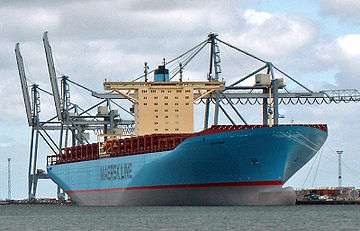East Jutland metropolitan area
| East Jutland Metropolitan Area (Byregion Østjylland) | |
| Greater Aarhus | |
| Region | |
 Core city Aarhus from Your Rainbow Ranorama | |
| Area | 11,521 km2 (4,448 sq mi) |
|---|---|
| Population | 1,378,978 (1. January 2016) |
| Density | 119/km2 (308/sq mi) |
|
East Jutland metropolitan area | |
East Jutland metropolitan area (Danish: Byregion Østjylland) or Greater Aarhus [1][2] is a geographic term for an area in Jutland and Funen, Denmark. [3]
The term denotes a functional coherent area linked by both infrastructure and labour across municipal boundaries. With about 1.4 million people living in the area it represents approximately 25% of the population of Denmark and is the second largest Metropolitan area after Greater Copenhagen.[4] The region has 19 municipalities as of 2016.[5] The area consist of Business Region Aarhus with a population of 960,000 to the north, and Trekantsområdet (The Triangle Region) with 418,000 people in the south.[6][7][8]
Economy
The metropolitan area is a major hub for education and is home to many large companies; in particular in the sectors of food production, agriculture, renewable energy and green tech. Major companies includes Vestas Wind Systems A/S and Arla Foods. Vestas is a Danish manufacturer, seller, installer, and servicer of wind turbines and the largest in the world of its kind; and Arla is a Swedish-Danish dairy cooperative with headquarters in Aarhus and is the largest producer of dairy products in Scandinavia and the seventh largest dairy company in the world, measured by turnover. Among cooperative dairy companies, Arla is the third largest in the world.

The primary harbour of the region is Aarhus harbour. It is the largest industrial harbour in Denmark and among largest in Northern Europe, only surpassed by the Swedish industrial harbour in Gothenburg in the Kattegat sea area. With modern facilities, it handles approximately 12 million tonnes of cargo (2006) per year and is therefore among the 100 biggest containerports in the world.[9]
Greater Aarhus boasts a unique position in the global wind energy market. It is home to some of the world’s biggest manufacturers of wind turbines and constitutes the world’s most advanced knowledge center. An array of suppliers and subcontractors, covers the entire supply chain and the sector benefits from a solid political backing of wind energy on local, regional and national level. The wind business cluster here has a long legacy of cooperation between manufacturers, suppliers, scientific communities and public authorities. As a knowledge hub and gathering point for the wind industry, Aarhus is likely to play a vital role in developing the wind energy systems of the future:
· 87% of Denmark’s combined turnover from wind energy is generated by businesses in the Greater Aarhus area
· 53% of Denmark´s high-skill wind employees work in the Greater Aarhus area
· 57% of all top executives in the Danish wind industry work in the Greater Aarhus area
· 14,000 employees in the Danish wind industry work within Central Region Denmark – 11,000 of them within one hour drive from Aarhus.[10]
Colleges and universities
- Aarhus University
- University of Southern Denmark
- Aarhus School of Architecture
- Aarhus School of Business
- Aarhus Technical College
- Engineering College of Aarhus
- The Danish School of Journalism
- VIA University College
Infrastructure

There are two primary commercial international airports serving the area:
- Aarhus Airport (in the north)
- Billund Airport (in the south)

The area has several motorways but the European route E45 is the motorway that goes from the south to the north and is more or less responsible for the growth in the area; it is along this motorway that the East Jutland metropolitan area is growing.
Statistics
Note that on 24 February 2016, Viborg municipality became a part of Business Region Aarhus. Contributing with a population of 95,776 and an area of 1,409 km2.[11]

|
The core area around Aarhus is the most populated area in East Jutland, and that area is much smaller in km² - 6,182 km² - (2386 sq. mi) and with a population of more than one million.
The figures below are for the core area centered on Aarhus and most populous area in the East Jutland metropolitan area as of 1 January 2016.[12]
| Municipality | Population | Area¹ | Density² | |
|---|---|---|---|---|
| Århus municipality | 330,639 | 468 | 698 | |
| Vejle municipality | 111,743 | 1,058 | 103 | |
| Randers municipality | 97,520 | 746 | 129 | |
| Kolding municipality | 91,695 | 607 | 145 | |
| Silkeborg municipality | 90,719 | 850 | 102 | |
| Horsens municipality | 87,736 | 519 | 166 | |
| Skanderborg municipality | 59,481 | 416 | 141 | |
| Fredericia municipality | 50,689 | 134 | 376 | |
| Favrskov municipality | 47,655 | 540 | 87 | |
| Hedensted municipality | 46,206 | 551 | 83 | |
| Odder municipality | 22,131 | 223 | 98 | |
| East jutland core area | 1,036,214 | 6,182 | 168 | |
The figures below are for the whole East Jutland metropolitan area as of 1 January 2016.[12]
| Municipality | Population | Area¹ | Density² | |
|---|---|---|---|---|
| Århus municipality | 330,639 | 468 | 698 | |
| Vejle municipality | 111,743 | 1,058 | 103 | |
| Randers municipality | 97,520 | 746 | 129 | |
| Viborg municipality | 95,776 | 1,409 | 68 | |
| Kolding municipality | 91,695 | 607 | 145 | |
| Silkeborg municipality | 90,719 | 850 | 102 | |
| Horsens municipality | 87,736 | 515 | 163 | |
| Skanderborg municipality | 59,481 | 416 | 140 | |
| Haderslev municipality | 56,029 | 815 | 69 | |
| Fredericia municipality | 50,689 | 134 | 376 | |
| Favrskov municipality | 47,655 | 540 | 87 | |
| Hedensted municipality | 46,206 | 551 | 83 | |
| Vejen municipality | 42,869 | 812 | 53 | |
| Syddjurs municipality | 41,889 | 689 | 59 | |
| Norddjurs municipality | 38,144 | 721 | 53 | |
| Middelfart municipality | 37,913 | 299 | 126 | |
| Billund municipality | 26,434 | 540 | 49 | |
| Odder municipality | 22,131 | 223 | 97 | |
| Samsø municipality | 3,710 | 113 | 32 | |
| Total East jutland metropolitan area | 1,378,978 | 11,521 | 119 | |
Pictures

 Outdoor museum The Old Town, Aarhus
Outdoor museum The Old Town, Aarhus Aarhus
Aarhus- ARoS art museum, Aarhus
 Aarhus
Aarhus
 Varna palace, Aarhus
Varna palace, Aarhus Skansen, Aarhus
Skansen, Aarhus Aarhus
Aarhus.jpg)
See also
References
- ↑ http://www.aarhus.dk/da/omkommunen/english.aspx
- ↑ http://www.aarhus.dk/~/media/Subsites/Aarhus-Wind-Energy/Dokumenter/Working-and-living.ashx
- ↑ "Information.dk: En stor by holder stor fest i storbyen – kan det blive større?, 2012". Information.dk. Archived from the original on 29 August 2012.
- ↑ "Danish Befolkningsforhold i Østjylland, Miljøministeriet, august 2008
- ↑ http://www2.blst.dk/udgiv/Publikationer/2008/978-87-92256-58-4/html/kap05.htm#5.1
- ↑ http://www.byregionoestjylland.dk/Statistik.html
- ↑ http://www.businessregionaarhus.dk/da/Den-oestjyske-millionby/Tal-om-Business-Region-Aarhus.aspx
- ↑ http://www.trekantomraadet.dk/
- ↑ XII.Godsomsætning, Århus Havn, 2000 (Danish)
- ↑ http://www.aarhus.dk/da/sitecore/content/Subsites/aarhuswindenergy/Home.aspx
- ↑ http://www.businessregionaarhus.dk/da/Den-oestjyske-millionby/Nyhedsliste/2016/1-Kvartal/Danmark-faar-en-ny-millionby.aspx
- 1 2 http://www.dst.dk/Statistik/kit.aspx
Sources
- https://web.archive.org/web/20090225003300/http://www.blst.dk/NR/rdonlyres/D57AF934-C471-41E6-A8B0-389AF80A94A6/0/Visionsoplaeg20082008.pdf (Danish)
- http://www.aarhuscity-info.dk/untitled.html%20oestjuske%20millionboe.html (Danish)
- http://www.tv2regionerne.dk/reg2005/player.aspx?id=405290&r=7 (Danish)
- http://www.frinet.dk/infrastruktur2030 (Danish)
- http://www.trafikdage.dk/doks/endeligtpaper/tdpaper107.pdf (Danish)
- http://jp.dk/indland/aar/article1226851.ece
- http://ing.dk/artikel/90253 (Danish)
- http://www.weekendavisen.dk/apps/pbcs.dll/article?AID=/20080808/SAMFUND/708080074/-1/samfund (Danish)
- http://www.global.aarhuskommune.dk/municipality-of-aarhus/aarhus-in-figures (English)
